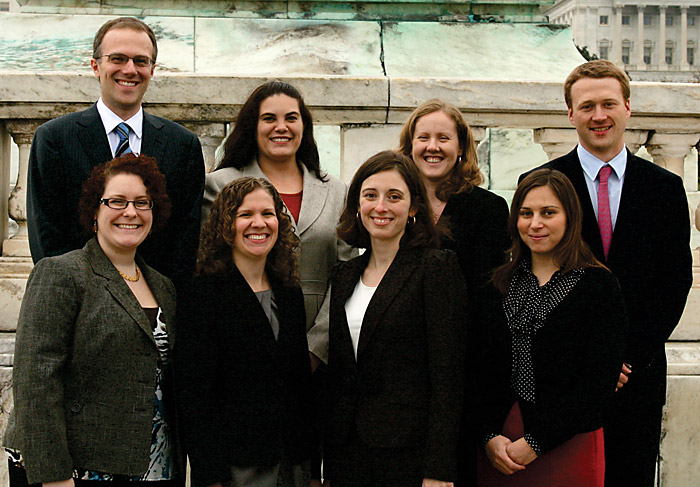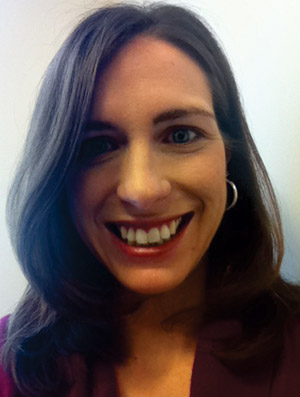Science fellows find policy ‟a perfect fit”
DOI: 10.1063/PT.3.1396
“I feel like I’m an ambassador for science,” says Anna Quider about her new position as a staff member for US Representative Russ Carnahan (D-MO). Thanks to a fellowship from the American Physical Society (APS), the University of Cambridge PhD astronomy graduate is now working on such issues as telecommunications, patent law, and education. “About halfway through [graduate school] I realized I didn’t want the traditional academic career,” says Quider, the daughter of a former politician in Buffalo, New York.
Quider is among more than 200 science and technology fellows serving 12-month terms in Congress and the executive branch. More than 30 scientific organizations partner with the American Association for the Advancement of Science (AAAS), which manages the fellowships, to place policy-minded scientists in federal offices or on committees that could benefit from their technical skills. This year the American Institute of Physics (AIP) and four of its member societies, including APS, are sponsoring nine PhD fellows.
The direct route
Like Quider, condensed-matter physicist Erin Boyd says she’s “fairly certain” she will pursue a career in public policy once her fellowship expires. For now, the Harvard University graduate is working on energy, environmental, and agricultural issues as an APS fellow in the office of Senator Al Franken (D-MN). Boyd says she hopes to eventually become involved with the “more detailed nitty-gritty of implementing policy” that is typically done in the executive branch, but she is enjoying the process of crafting policy in the Senate.
“I’ve been interested in public policy since I was a little kid,” says chemist TJ Augustine, a Stanford University graduate. Cosponsored by the Optical Society of America (OSA) and SPIE, he is working on energy, environment, and health-care policy as a staff member for Sen. Dick Durbin (D-IL). Augustine views the AAAS program as “the most direct route [for scientists] to a career in policy.” As a graduate student, OSA/Materials Research Society (MRS) fellow Laura Povlich decided to pursue policy after participating in a Washington, DC, immersion experience coordinated by the Consortium for Science, Policy, and Outcomes at Arizona State University. A University of Michigan graduate with a degree in macromolecular science and engineering, Povlich is working in the office of Rep. Sander Levin (D-MI) on health-care policy and on health-technology innovation.
“I think [the policy world] is going to be a good place for me,” says astrophysicist Meredith Drosback, a graduate of the University of Colorado at Boulder and one of two AIP congressional fellows this year. As a staff member on the Senate Committee on Commerce, Science, and Transportation, she contributes to legislation that affects NASA and NIST. Drosback says she already has a clearer perspective on the difference between academia and politics: “[The former] is built on ideas and the other on relationships. In policy, reading a report is not as effective as talking to someone.” Also an AIP fellow, University College of London graduate Makenzie Lystrup is working in the office of Rep. Edward Markey (D-MA). Her portfolio includes nuclear nonproliferation, homeland security, and science R&D. Lystrup calls astronomy her “first love,” but says she plans to “stay in policy or at least in a role where I have the opportunity to translate science across different communities.”
The American Geophysical Union is sponsoring two congressional fellows this year: geoscientist Rebecca French and atmospheric scientist Ian Lloyd. A Virginia Tech graduate, French is working on climate change and environmental issues for Sen. Bernie Sanders (I-VT); she says her career goals include landing a senior scientist position at a nongovernmental organization (NGO). Lloyd, a Princeton University graduate, is working on energy, environment, and foreign policy in the office of Sen. Jeff Merkley (D-OR). He, too, says he’s interested in working on science policy at an NGO or a nonprofit foundation. For now, he’s learning that the expectation for fellows is to “stick to the facts when you’re wearing your science hat. . . . [But] after you figure out the right policy, then you need to figure out the right politics.”
After a one-year hiatus, AIP has resumed its sponsorship of a fellow for the State Department; the recipient this year is Sarah Case, a condensed-matter physics graduate of the University of Chicago. Prior to her fellowship, Case served for three years as a program officer at the National Research Council, where she directed studies on the role of nuclear energy in the US future energy mix and worked with the Department of Energy on assessing proliferation risks in nuclear fuel cycles. She is now working on nonproliferation, export controls, and other science-related issues in the Chinese and Mongolian affairs office of the Bureau of East Asian and Pacific Affairs. “The State Department is a perfect fit for me,” says Case, who hopes to work on US–China relations following the fellowship.
High-value expertise
Many of last year’s AIP-affiliated fellows are following through with their stated intentions to pursue policy (see PHYSICS TODAY, January 2011, page 30
With his OSA/SPIE fellowship, which he extended to work with the Senate Committee on Energy and Natural Resources, atomic physicist Marcius Extavour worked on legislative proposals in response to the reduction in supplies of rare-earth metals from China and helium from the federal reserves. Ecologist Ilya Fischhoff, who extended his AGU fellowship to work with the House Committee on Natural Resources, says he enjoyed preparing staff members for committee hearings and “seeing the debates up close.”
Plasma physicist Laura Berzak Hopkins, an APS fellow last year, has accepted a research position at Lawrence Livermore National Laboratory. From her experience on the House Committee on Foreign Affairs and in the office of Sen. Kent Conrad (D-ND), Hopkins says she learned that “the reality of the political arena is that everything has to be some form of compromise.” Last year’s OSA/MRS fellow Ashley White is now a AAAS fellow in NSF’s division of materials research. A materials scientist, White says she intends to return to academia, but she credits her experience working in Franken’s office with giving her a better perspective on the impact of government policy on higher education.
For details on sponsorship through AIP or its member societies, visit http://aip.org/gov/fellowships.html

Congressional fellows sponsored by the American Institute of Physics and its member societies this year. In the front row, from left, are Anna Quider, Laura Povlich, Erin Boyd, and Makenzie Lystrup; in the back row, from left, are TJ Augustine, Meredith Drosback, Rebecca French, and Ian Lloyd.


Sarah Case, AIP State Department Fellow

